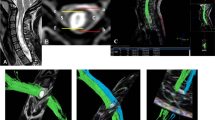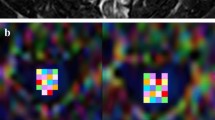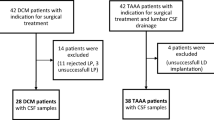Abstract
Study design:
A cross-sectional observational study.
Objectives:
The aim of this study is to compare the apparent diffusion coefficient (ADC) and fractional anisotropy (FA) between patients with cervical spondylotic myelopathy (CSM) with and without high T2-weighted signal intensity, and to correlate each parameter with clinical assessments.
Setting:
CSM is a common cause of spinal cord dysfunction. The significance of T2 high signal intensity in the prognosis of CSM remains controversial.
Methods:
Diffusion tensor imaging was performed at the cervical spinal cord in 40 patients with CSM and 42 healthy subjects. Patients with high signal intensity were separated from those without high signal intensity. ADC and FA values were compared among different groups, and the correlation between each parameter and the modified Japanese Orthopedic Association (mJOA) score was examined.
Results:
The ADC and FA values of C2/3 differed significantly from those of C5/6 and C6/7 in healthy subjects. Patients with CSM had a higher ADC but a lower FA value than did healthy subjects. In all patients with CSM, there was a negative linear correlation between ADC and mJOA score, but FA value correlated positively with mJOA score. Secondary analysis suggested that FA value in patients with high signal intensity was lower than that in patients without high signal intensity. FA value showed a positive linear correlation with mJOA score in the patients with high signal intensity but not in the patients without high signal intensity.
Conclusions:
Patients with high signal intensity may have more severe spinal cord injury than patients without high signal intensity, and FA may be a useful indicator of functional status in patients with CSM with high signal intensity.
Similar content being viewed by others
Log in or create a free account to read this content
Gain free access to this article, as well as selected content from this journal and more on nature.com
or
References
Irwin ZN, Hilibrand A, Gustavel M, McLain R, Shaffer W, Myers M et al. Variation in surgical decision making for degenerative spinal disorders. Part II: cervical spine. Spine 2005; 30: 2214–2219.
Holly LT, Matz PG, Anderson PA, Groff MW, Heary RF, Kaiser MG et al. Clinical prognostic indicators of surgical outcome in cervical spondylotic myelopathy. J Neurosurg Spine 2009; 11: 112–118.
Zhang P, Shen Y, Zhang YZ, Ding WY, Wang LF . Significance of increased signal intensity on MRI in prognosis after surgical intervention for cervical spondylotic myelopathy. J Clin Neurosci 2011; 18: 1080–1083.
Uchida K, Nakajima H, Takeura N, Yayama T, Guerrero AR, Yoshida A et al. Prognostic value of changes in spinal cord signal intensity on magnetic resonance imaging in patients with cervical compressive myelopathy. Spine J 2014; 14: 1601–1610.
Ellingson BM, Salamon N, Holly LT . Advances in MR imaging for cervical spondylotic myelopathy. Eur Spine J 2013; 45: 432–438.
Kelley BJ, Harel NY, Kim CY, Papademetris X, Coman D, Wang X et al. Diffusion tensor imaging as a predictor of locomotor function after experimental spinal cord injury and recovery. J Neurotrauma 2014; 31: 1362–1373.
Jones JG, Cen SY, Lebel RM, Hsieh PC, Law M . Diffusion tensor imaging correlates with the clinical assessment of disease severity in cervical spondylotic myelopathy and predicts outcome following surgery. AJNR Am J Neuroradiol 2013; 34: 471–478.
Petersen JA, Wilm BJ, von Meyenburg J, Schubert M, Seifert B, Najafi Y et al. Chronic cervical spinal cord injury: DTI correlates with clinical and electrophysiological measures. J Neurotrauma 2012; 29: 1556–1566.
Oh J, Zackowski K, Chen M, Newsome S, Saidha S, Smith SA et al. Multiparametric MRI correlates of sensorimotor function in the spinal cord in multiple sclerosis. Mult Scler 2013; 19: 427–435.
Li F, Chen Z, Zhang F, Shen H, Hou T . A meta-analysis showing that high signal intensity on T2-weighted MRI is associated with poor prognosis for patients with cervical spondylotic myelopathy. J Clin Neurosci 2011; 18: 1592–1595.
Yukawa Y, Kato F, Yoshihara H, Yanase M, Ito K . MR T2 image classification in cervical compression myelopathy: predictor of surgical outcomes. Spine (Phila Pa 1976) 2007; 32: 1675–1678.
Alafifi T, Kern R, Fehlings M . Clinical and MRI predictors of outcome after surgical intervention for cervical spondylotic myelopathy. J Neuroimaging 2007; 17: 315–322.
Mastronardi L, Elsawaf A, Roperto R, Bozzao A, Caroli M, Ferrante M et al. Prognostic relevance of the postoperative evolution of intramedullary spinal cord changes in signal intensity on magnetic resonance imaging after anterior decompression for cervical spondylotic myelopathy. J Neurosurg Spine 2007; 7: 615–622.
Matsumoto M, Toyama Y, Ishikawa M, Chiba K, Suzuki N, Fujimura Y . Increased signal intensity of the spinal cord on magnetic resonance images in cervical compressive myelopathy. Does it predict the outcome of conservative treatment? Spine (Phila Pa 1976) 2000; 25: 677–682.
Suri A, Chabbra RP, Mehta VS, Gaikwad S, Pandey RM . Effect of intramedullary signal changes on the surgical outcome of patients with cervical spondylotic myelopathy. Spine J 2003; 3: 33–45.
Budzik JF, Balbi V, Le Thuc V, Duhamel A, Assaker R, Cotten A . Diffusion tensor imaging and fibre tracking in cervical spondylotic myelopathy. Eur Radiol 2011; 21: 426–433.
Ellingson BM, Ulmer JL, Kurpad SN, Schmit BD . Diffusion tensor MR imaging of the neurologically intact human spinal cord. AJNR Am J Neuroradiol 2008; 29: 1279–1284.
Zhang C, Das SK, Yang DJ, Yang HF . Application of magnetic resonance imaging in cervical spondylotic myelopathy. World J Radiol 2014; 6: 826–832.
Staempfli P, Reischauer C, Jaermann T, Valavanis A, Kollias S, Boesiger P . Combining fMRI and DTI: a framework for exploring the limits of fMRI-guided DTI fiber tracking and for verifying DTI-based fiber tractography results. Neuroimage 2008; 39: 119–126.
Jones J, Lerner A, Kim PE, Law M, Hsieh PC . Diffusion tensor imaging in the assessment of ossification of the posterior longitudinal ligament: a report on preliminary results in 3 cases and review of the literature. Neurosurg Focus 2011; 30: E14.
Wen CY, Cui JL, Liu HS, Mak KC, Cheung WY, Luk KD et al. Is diffusion anisotropy a biomarker for disease severity and surgical prognosis of cervical spondylotic myelopathy. Radiology 2014; 270: 197–204.
Chen X, Kong C, Feng S, Guan H, Yu Z, Cui L et al. Magnetic resonance diffusion tensor imaging of cervical spinal cord and lumbosacral enlargement in patients with cervical spondylotic myelopathy. J Magn Reson Imaging 2016; 43: 1484–1491.
Takahashi M, Sakamoto Y, Miyawaki M, Bussaka H . Increased MR signal intensity secondary to chronic cervical cord compression. Neuroradiology 1987; 29: 550–556.
Al-Mefty O, Harkey LH, Middleton TH, Smith RR, Fox JL . Myelopathic cervical spondylotic lesions demonstrated by magnetic resonance imaging. J Neurosurg 1988; 68: 217–222.
Naderi S, Ozgen S, Pamir MN, Ozek MM, Erzen C . Cervical spondylotic myelopathy: surgical results and factors affecting prognosis. Neurosurgery 1998; 43: 43–50.
Nakamura M, Fujimura Y . Magnetic resonance imaging of the spinal cord in cervical ossification of the posterior longitudinal ligament: can it predict surgical outcome? Spine 1998; 23: 38–40.
Avadhani A, Rajasekaran S, Shetty AP . Comparison of prognostic value of different MRI classifications of signal intensity change in cervical spondylotic myelopathy. Spine J 2010; 10: 475–485.
Hirabayashi K, Miyakawa J, Satomi K, Maruyama T, Wakano K . Operative results and postoperative progression of ossification among patients with ossification of cervical posterior longitudinal ligament. Spine 1981; 6: 354–364.
Chen CJ, Lyu RK, Lee ST, Wong YC, Wang LJ . Intramedullary high signal intensity on T2-weighted MR images in cervical spondylotic myelopathy: prediction of prognosis with type of intensity. Radiology 2001; 221: 789–794.
Yukawa Y, Kato F, Yoshihara H, Yanase M, Ito K . MR T2 image classification in cervical compression myelopathy: predictor of surgical outcomes. Spine 2007; 32: 1675–1679.
Yukawa Y, Kato F, Ito K, Horie Y, Hida T, Machino M et al. Postoperative changes in spinal cord signal intensity in patients with cervical compression myelopathy: comparison between preoperative and postoperative magnetic resonance images. J Neurosurg Spine 2008; 8: 524–528.
Al-Mefty O, Harkey HL, Marawi I, Haines DE, Peeler DF, Wilner HI et al. Experimental chronic compressive cervical myelopathy. J Neurosurg 1993; 79: 550–561.
Ohshio I, Hatayama A, Kaneda K, Takahara M, Nagashima K . Correlation between histopathologic features and magnetic resonance images of spinal cord lesions. Spine 1993; 18: 1140–1149.
Vedantam A, Eckardt G, Wang MC, Schmit BD, Kurpad SN . Clinical correlates of high cervical fractional anisotropy in acute cervical spinal cord injury. World Neurosurg 2015; 83: 824–828.
Acknowledgements
We thank Claire F Levine, MS, ELS (scientific editor, Department of Anesthesiology/CCM, Johns Hopkins University) for editing the manuscript. This study was supported by grant from the Science and Technology Commission of Tongzhou District. This study was funded by Beijing Natural Science Foundation Program and Scientific Research Key Program of Beijing Municipal Commission of Education (KM 201710025028) and Capital Characteristic Clinical Project (Z161100000116064).
Author information
Authors and Affiliations
Corresponding authors
Ethics declarations
Competing interests
The authors declare no conflict of interest.
Rights and permissions
About this article
Cite this article
Liu, Y., Kong, C., Cui, L. et al. Correlation between diffusion tensor imaging parameters and clinical assessments in patients with cervical spondylotic myelopathy with and without high signal intensity. Spinal Cord 55, 1079–1083 (2017). https://doi.org/10.1038/sc.2017.75
Received:
Revised:
Accepted:
Published:
Issue date:
DOI: https://doi.org/10.1038/sc.2017.75
This article is cited by
-
Leverage of applying diffusion tensor imaging (DTI) indices in assessment of cervical spondylotic myelopathy
Egyptian Journal of Radiology and Nuclear Medicine (2024)



